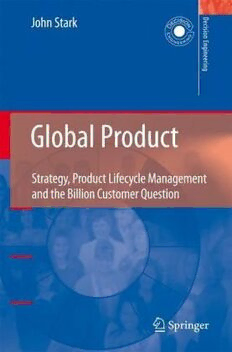Download Global Product: Strategy, Product Lifecycle Management and the Billion Customer Question (Decision Engineering) PDF Free - Full Version
Download Global Product: Strategy, Product Lifecycle Management and the Billion Customer Question (Decision Engineering) by John Stark in PDF format completely FREE. No registration required, no payment needed. Get instant access to this valuable resource on PDFdrive.to!
About Global Product: Strategy, Product Lifecycle Management and the Billion Customer Question (Decision Engineering)
In the early years of the 21st Century, as a result of many changes, it has become possible for the first time for tens of thousands of companies to offer manufactured products to customers across six continents. For many of these ''global products'', there are potentially more than a billion customers. In 2007, Wall Street hit new highs as the enormous opportunity for increased sales and profits became clear. However the new environment is not easy to manage and the risks are high.Meeting the various requirements of customers from a range of countries, choosing the most suitable locations for the different stages of development and manufacturing, deciding what can be global and what must be local, implementing suitable processes and systems, accommodating different national regulations, and efficiently dividing the workload between diverse sites are among the many challenges faced by providers of global products.Product Lifecycle Management is now used worldwide to manage the innovation, development and support of global products. This key new business activity manages a product anywhere in the world, at any time in its life: from the first idea through to recycling and disposal.Based on interviews with executives and managers in companies such as ABB, Alcatel-Lucent, Dow Corning and Siemens, Global Product outlines the new environment and driving forces, and the resulting opportunities and challenges. From lessons learned, it draws conclusions about best practices and the ground rules for successful strategies, structures and implementation. In addition, the objectives and components of Product Lifecycle Management are highlighted.
Detailed Information
| Author: | John Stark |
|---|---|
| Publication Year: | 2007 |
| ISBN: | 9781846289149 |
| Pages: | 224 |
| Language: | English |
| File Size: | 3.672 |
| Format: | |
| Price: | FREE |
Safe & Secure Download - No registration required
Why Choose PDFdrive for Your Free Global Product: Strategy, Product Lifecycle Management and the Billion Customer Question (Decision Engineering) Download?
- 100% Free: No hidden fees or subscriptions required for one book every day.
- No Registration: Immediate access is available without creating accounts for one book every day.
- Safe and Secure: Clean downloads without malware or viruses
- Multiple Formats: PDF, MOBI, Mpub,... optimized for all devices
- Educational Resource: Supporting knowledge sharing and learning
Frequently Asked Questions
Is it really free to download Global Product: Strategy, Product Lifecycle Management and the Billion Customer Question (Decision Engineering) PDF?
Yes, on https://PDFdrive.to you can download Global Product: Strategy, Product Lifecycle Management and the Billion Customer Question (Decision Engineering) by John Stark completely free. We don't require any payment, subscription, or registration to access this PDF file. For 3 books every day.
How can I read Global Product: Strategy, Product Lifecycle Management and the Billion Customer Question (Decision Engineering) on my mobile device?
After downloading Global Product: Strategy, Product Lifecycle Management and the Billion Customer Question (Decision Engineering) PDF, you can open it with any PDF reader app on your phone or tablet. We recommend using Adobe Acrobat Reader, Apple Books, or Google Play Books for the best reading experience.
Is this the full version of Global Product: Strategy, Product Lifecycle Management and the Billion Customer Question (Decision Engineering)?
Yes, this is the complete PDF version of Global Product: Strategy, Product Lifecycle Management and the Billion Customer Question (Decision Engineering) by John Stark. You will be able to read the entire content as in the printed version without missing any pages.
Is it legal to download Global Product: Strategy, Product Lifecycle Management and the Billion Customer Question (Decision Engineering) PDF for free?
https://PDFdrive.to provides links to free educational resources available online. We do not store any files on our servers. Please be aware of copyright laws in your country before downloading.
The materials shared are intended for research, educational, and personal use in accordance with fair use principles.

